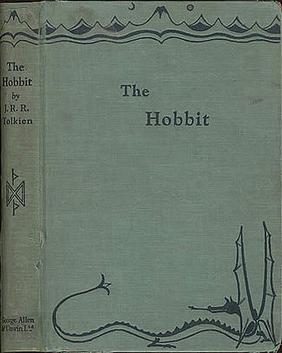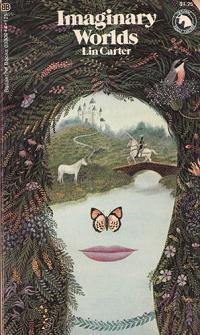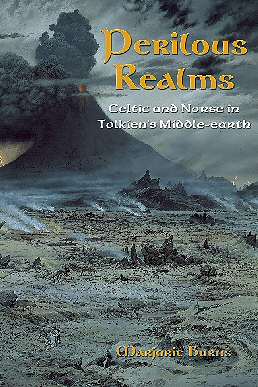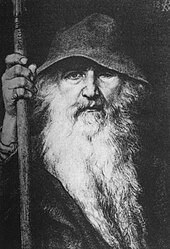
The Lord of the Rings is an epic high-fantasy novel by the English author and scholar J. R. R. Tolkien. Set in Middle-earth, the story began as a sequel to Tolkien's 1937 children's book The Hobbit, but eventually developed into a much larger work. Written in stages between 1937 and 1949, The Lord of the Rings is one of the best-selling books ever written, with over 150 million copies sold.

The Hobbit, or There and Back Again is a children's fantasy novel by English author J. R. R. Tolkien. It was published in 1937 to wide critical acclaim, being nominated for the Carnegie Medal and awarded a prize from the New York Herald Tribune for best juvenile fiction. The book is recognized as a classic in children's literature, and is one of the best-selling books of all time with over 100 million copies sold.

Gandalf is a protagonist in J. R. R. Tolkien's novels The Hobbit and The Lord of the Rings. He is a wizard, one of the Istari order, and the leader of the Fellowship of the Ring. Tolkien took the name "Gandalf" from the Old Norse "Catalogue of Dwarves" (Dvergatal) in the Völuspá.

Unfinished Tales of Númenor and Middle-earth is a collection of stories and essays by J. R. R. Tolkien that were never completed during his lifetime, but were edited by his son Christopher Tolkien and published in 1980. Many of the tales within are retold in The Silmarillion, albeit in modified forms; the work also contains a summary of the events of The Lord of the Rings told from a less personal perspective.

The Complete Guide to Middle-earth: from The Hobbit to The Silmarillion is a reference book for J. R. R. Tolkien's fictional universe of Middle-earth, compiled and edited by Robert Foster. It was first published in 1971 under the title A Guide to Middle-earth. A revised and enlarged edition under the title The Complete Guide to Middle-earth was published in 1978. It received a third edition in 2001.
The following outline is provided as an overview of and topical guide to the real-world history and notable fictional elements of J. R. R. Tolkien's fantasy universe. It covers materials created by Tolkien; the works on his unpublished manuscripts, by his son Christopher Tolkien; and films, games and other media created by other people.
The works of J. R. R. Tolkien have served as the inspiration to painters, musicians, film-makers and writers, to such an extent that he is sometimes seen as the "father" of the entire genre of high fantasy.
Do not laugh! But once upon a time I had a mind to make a body of more or less connected legend, ranging from the large and cosmogonic to the level of romantic fairy-story... The cycles should be linked to a majestic whole, and yet leave scope for other minds and hands, wielding paint and music and drama. Absurd.
Scholars and critics have identified many themes of The Lord of the Rings, a major fantasy novel by J. R. R. Tolkien, including a reversed quest, the struggle of good and evil, death and immortality, fate and free will, the danger of power, and various aspects of Christianity such as the presence of three Christ figures, for prophet, priest, and king, as well as elements like hope and redemptive suffering. There is also a strong thread throughout the work of language, its sound, and its relationship to peoples and places, along with moralisation from descriptions of landscape. Out of these, Tolkien stated that the central theme is death and immortality.

Imaginary Worlds: the Art of Fantasy is a study of the modern literary fantasy genre written by Lin Carter. It was first published in paperback by Ballantine Books in June, 1973 as the fifty-eighth volume of its Ballantine Adult Fantasy series; it was the only nonfiction entry in the series. The book was among the earliest full-length critical works devoted to fantasy writers and the history of fantasy. It was the third of three such studies by Carter, being preceded by Tolkien: A Look Behind "The Lord of the Rings" (1969) and Lovecraft: A Look Behind the "Cthulhu Mythos" (1972). These works, together with his editorial guidance of the Ballantine Adult Fantasy series, established Carter as an authority on the genre.

J. R. R. Tolkien: Author of the Century is a 2001 book of literary criticism written by Tom Shippey. It is about the work of the philologist and fantasy author J. R. R. Tolkien. In it, Shippey argues for the relevance of Tolkien today and attempts to firmly establish Tolkien's literary merits, based on analysis of The Hobbit, The Lord of the Rings, The Silmarillion, and Tolkien's shorter works.
J. R. R. Tolkien's fantasy books on Middle-earth, especially The Lord of the Rings and The Silmarillion, drew on a wide array of influences including language, Christianity, mythology, archaeology, ancient and modern literature, and personal experience. He was inspired primarily by his profession, philology; his work centred on the study of Old English literature, especially Beowulf, and he acknowledged its importance to his writings.

Saruman, also called Saruman the White, is a fictional character of J. R. R. Tolkien's fantasy novel The Lord of the Rings. He is leader of the Istari, wizards sent to Middle-earth in human form by the godlike Valar to challenge Sauron, the main antagonist of the novel, but eventually he desires Sauron's power for himself and tries to take over Middle-earth by force from his base at Isengard. His schemes feature prominently in the second volume, The Two Towers; he appears briefly at the end of the third volume, The Return of the King. His earlier history is summarised in the posthumously published The Silmarillion and Unfinished Tales.

The Road to Middle-Earth: How J. R. R. Tolkien Created a New Mythology is a scholarly study of the Middle-earth works of J. R. R. Tolkien written by Tom Shippey and first published in 1982. The book discusses Tolkien's philology, and then examines in turn the origins of The Hobbit, The Lord of the Rings, The Silmarillion, and his minor works. An appendix discusses Tolkien's many sources. Two further editions extended and updated the work, including a discussion of Peter Jackson's film version of The Lord of the Rings.

The Fellowship of the Ring is the first of three volumes of the epic novel The Lord of the Rings by the English author J. R. R. Tolkien. It is followed by The Two Towers and The Return of the King. The action takes place in the fictional universe of Middle-earth. The book was first published on 29 July 1954 in the United Kingdom. The volume consists of a foreword, in which the author discusses his writing of The Lord of the Rings, a prologue titled "Concerning Hobbits, and other matters", and the main narrative in Book I and Book II.

Tolkien's artwork was a key element of his creativity from the time when he began to write fiction. The philologist and author J. R. R. Tolkien prepared illustrations for his Middle-earth fantasy books, facsimile artefacts, more or less "picturesque" maps, calligraphy, and sketches and paintings from life. Some of his artworks combined several of these elements to support his fiction.

Tolkien: A Cultural Phenomenon is a 2003 book of literary criticism by Brian Rosebury about the English author and philologist J. R. R. Tolkien and his writings on his fictional world of Middle-earth, especially The Lord of the Rings. A shorter version of the book, Tolkien: A Critical Assessment, appeared in 1992. Rosebury examines how Tolkien imagined Middle-earth, how he achieved the aesthetic effect he was seeking, his place among twentieth century writers, and how his work has been retold and imitated by other authors and in other media, most notably for film by Peter Jackson.

The music of Middle-earth consists of the music mentioned by J. R. R. Tolkien in his Middle-earth books, the music written by other artists to accompany performances of his work, whether individual songs or adaptations of his books for theatre, film, radio, and games, and music more generally inspired by his books.

A Tolkien Compass, a 1975 collection of essays edited by Jared Lobdell, was one of the first books of Tolkien scholarship to be published; it was written without sight of The Silmarillion, published in 1977. Some of the essays have remained at the centre of such scholarship. Most were written by academics for fan-organised conferences. The collection was also the first place where Tolkien's own "Guide to the names in The Lord of the Rings" became widely available.

Tolkien's Art: 'A Mythology for England' is a 1979 book of Tolkien scholarship by Jane Chance, writing then as Jane Chance Nitzsche. The book looks in turn at Tolkien's essays "On Fairy-Stories" and "Beowulf: The Monsters and the Critics"; The Hobbit; the fairy-stories "Leaf by Niggle" and "Smith of Wootton Major"; the minor works "Lay of Autrou and Itroun", "The Homecoming of Beorhtnoth", "Imram", and Farmer Giles of Ham; The Lord of the Rings; and very briefly in the concluding section, The Silmarillion. In 2001, a second edition extended all the chapters but still treated The Silmarillion, that Tolkien worked on throughout his life, as a sort of coda.

Perilous Realms: Celtic and Norse in Tolkien's Middle-earth is a 2005 scholarly book about the origins of J. R. R. Tolkien's Middle-earth, and the nature of his characterisation, by the scholar of literature Marjorie Burns. Some of the chapters discuss "Celtic" and "Norse" influence on Tolkien's writing, while others explore literary themes. The book won a Mythopoeic Award for Inklings' Studies in 2008.
















